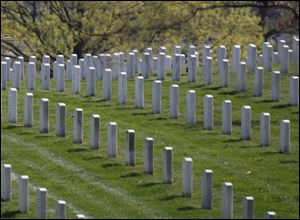
Let them in: Keep Arlington Cemetery for all eligible vets
6/8/2018
Graves housing on the remains of U.S. military personnel are seen at Arlington National Cemetery in Arlington, Va.
A promise made to the nation’s veterans is a promise that must be kept. As long as there’s space at Arlington National Cemetery, any currently eligible veteran who wants to be buried there should have that right.
Click here to view more Blade editorials
With graves dating to the Civil War, and hallowed grounds in the shadow of the nation’s capital that once belonged to George Washington’s kin, Arlington is the best known of America’s 135 national cemeteries. As many as 30 funerals are held there each weekday, with another six to eight each Saturday. More than 420,000 veterans and relatives already are buried there, and space at the 624-acre cemetery is likely to run out within 25 years if the number of interments continues at the present rate.
Among other ideas, federal authorities now are considering a suggestion to begin limiting Arlington burials to those killed in action or awarded the Medal of Honor. That, according to one news report, could mean fewer burials over the course of a year than now occur there in a week. That could help to prolong the cemetery’s life for another 150 years, barring some large war that renders such projections meaningless.
But going that route also would be breaking a contract with many veterans who were promised the option of burial there. Arlington’s in-ground burial policies are the strictest of any national cemetery, yet according to its website, those eligible include active-duty and retired service members; recipients of certain medals, including the Purple Heart; former prisoners of war; and certain relatives. Above-ground inurnment is available to a wider group who served, plus certain relatives.
Not surprisingly, Arlington, home to the Tomb of the Unknown Solider and President John F. Kennedy’s grave, is the most popular national cemetery.
Not all veterans want to be buried in Arlington or any national cemetery. But some have their hearts set on Arlington, perhaps for the honor of sharing a sacred space with so many heroes from so many wars or perhaps to be rejoined with their own brothers in arms. This is a small courtesy and should not be denied them any more than the federal government should backtrack on promises of post-service health care or educational assistance provided under the GI Bill.
The government should leave the current rules intact and bury all eligible veterans and relatives who choose Arlington until the space there runs out. This is what some veterans already are demanding.
In the meantime, the government should better promote the other 134 national cemeteries. Each is beautiful and distinguished in its own way and well serves veterans close to their homes. The Fort Bliss National Cemetery in Texas offers views of the Franklin Mountains, for example, while the Georgia National Cemetery looks onto the Blue Ridge Mountains and Lake Allatoona. Not least among these gems is the National Cemetery of the Alleghenies on a longtime farm in Cecil, Washington County.
The government also should begin making plans for a new cemetery to succeed Arlington or serve as an extension of it. With input from veterans, the new site can be designed so as to echo the honor and grandeur of the original.